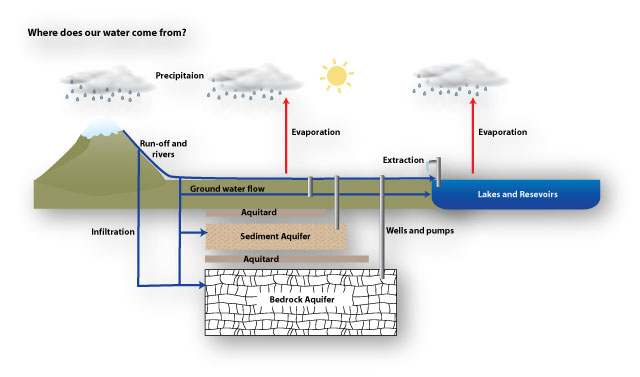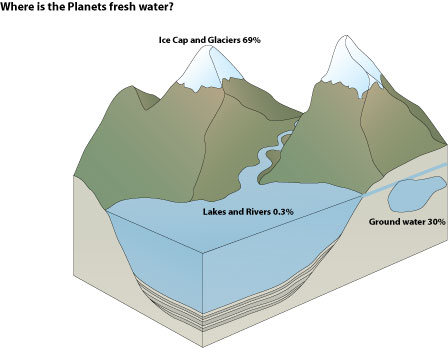3.6. 1: Describe the Earth’s water budget.
Most of the water on earth is saline, residing in the sea. Less than 0.26% is freshwater. Of this fresh water resource, only 0.3 % exist as surface-water and 30% as groundwater the remainder is locked in ice and so unavailable as a resource. Only around 1% of the resource portion of freshwater is easily extracted, though only 9% of this proportion is currently used for water supply. Of the total water on Earth there is a very small portion actual available to man.
How do we get the water that we use? The water that supplies man’s needs is taken from various water source. The most common sources of water include rivers, reservoirs and lakes, and groundwater. The water taken from rivers, lakes and reservoirs us known as surface water. Surface water can start its life either as rainfall or melt water from snow and ice. Surface run off runs initially into gullies and small streams until it encounters a larger body of water, before its final journey to the oceans. Anywhere in this journey, before it reaches the oceans, water can be extracted for use by man.

Sometimes surface water sinks into the ground and becomes ground water. Any water that is underground is groundwater and accounts for the largest proportion of water used by man. During the water cycle, precipitation is absorbed into the ground entering watersheds and aquifers.
Under the right conditions, rock strata and sediments that are permeable, water will move down via gravity until it reaches an impermeable clays or rocks and then begins to move laterally. This creates a saturated saturated zone, the highest point of which the water table. The water table change seasonally as rainfall changes.
Because groundwater flows through layers of sand, clay, rock, and gravel a natural filtration process takes place. The result is that groundwater is generally cleaner than water on the surface.
Problems with the Worlds Water
Not all of the fresh water on the Earth is where it needs to be. Seasonality in precipitation can have a dramatic effect on the availability of fresh water. In the drought prone areas of the world people may have to travel many kilometers to use communal wells and river supplies. The water distribution and storage systems that much of the developed world takes for granted,mains supply and reservoirs, do not exist in many developing countries.
Significant drought periods are becoming a more common feature of many parts of the world. While countries such as Ethiopia make dramatic headlines, even areas of the USA and Spain have suffered prolonged periods of much lower than expected precipitation leading to water shortages. Increased abstraction from rivers and ground water in the Catalan region of Spain has drastically added to the worst drought that the region had experienced in 40 years resulted in a mini fleet of tanker ships having to bring water from the river Rhone in France during 2008.
As well as problems with supply directly, the fitness and health safety of much of the worlds freshwater is also a major issue. Both surface and ground water supplies in many parts of the world are affected directly by pollution and contamination. This can occur either directly with water sources being used as sewers or places to dump pollutants, or indirectly where contaminants enter water supply through surface run off or by ifiltration into the ground supply. Excess use of nitrogen based fertilizers can lead to eutrophication of water sources and growths of often toxic algal blooms. A 2002 report by Essex University estimated that the cost of removing nitrates from UK drinking water was in more than £20 million.
As water the demand for water increases with increasing population another so the reserves of water being used become ever smaller. This has led in places to the process of salination. Increased mineral salt levels in water sources. Salination is a particular problem in those regions that have also been affected by prolonged drought. Salinity levels have risen dramatically in aquifer storage as well as in lakes and rivers around the world as they have dried up.
